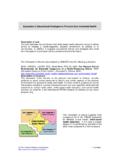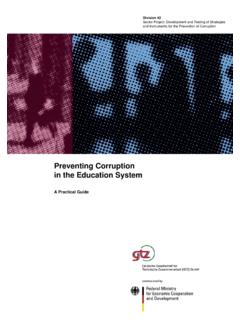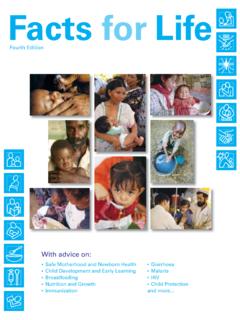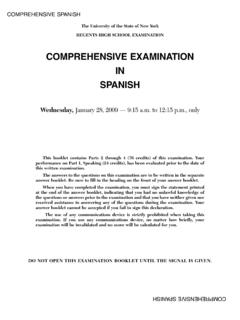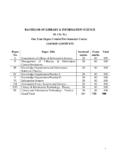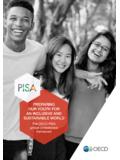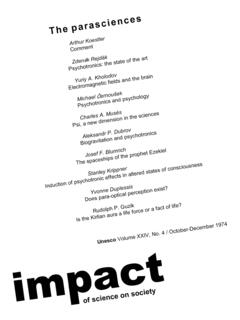Transcription of Universal Precautions to Prevent the Transmission …
1 FRESH Tools for Effective School Health First Edition 2004 Universal Precautions to Prevent the Transmission of HIV The information in this tool was adapted by unesco from the following publications: Education International, WHO, unesco 2001. Training and Resource Manual on School Health and HIV/STI Prevention; and WHO, UNAIDS, unesco , 1999. WHO Information Series on School Health, Document Six: Preventing HIV/AIDS STI and Related Discrimination: An Important Responsibility of Health-Promoting Schools.
2 Description of the documents: The first provides teachers and trade union leaders working in the field of HIV/AIDS prevention with resources and examples of interactive skill-building activities designed to strengthen their teaching and advocacy skills. The second explains how HIV prevention programmes can be effective in reducing the risk of HIV infection among young people and offers suggestions as to how schools can work with the community to identify and implement appropriate and effective ways to Prevent HIV infection among young people.
3 Description of the tool: Universal infection-control Precautions are practices that schools, like other organizations, need to follow to Prevent a variety of diseases. Precautions should include policies on caring for wounds, cleaning-up blood spills and disposing of medical supplies. This tool describes the standard Precautions to be taken in schools to Prevent HIV Transmission , along with a list of the supplies that the school will need in order to apply them. This information supports Core Component #4 of the FRESH framework for effective school health: skills-based health education.
4 It will have a greater impact if it is reinforced by activities in the other three components of the framework. FRESH Tools for Effective School Health First Edition 2004 1 Universal Precautions to Prevent the Transmission of HIV1 Normal teaching and learning activities do not place anyone at risk for HIV infection, but accidents and injuries at school can produce situations where students or staff might be exposed to another person s body fluids. Because very often people do not know they are infected with HIV, and as it is not possible to tell someone is infected by the way he or she looks, school personnel should apply Universal Precautions to every person and every body fluid in every situation.
5 Universal infection-control Precautions are practices that schools, like other organizations, need to follow to Prevent a variety of diseases. Precautions should include policies on caring for wounds, cleaning-up blood spills and disposing of medical supplies. While these Precautions are valuable in preventing certain diseases, such as flu, chicken pox or ear infections, schools must recognize that HIV is more difficult to transmit. HIV and other sexually transmitted infections are not transmitted by casual contact, such as shaking hands, hugging, using toilet seats or sharing eating utensils.
6 Even kissing or deep kissing does not transmit HIV. Universal Precautions are simply policies and procedures that schools establish and follow as safeguards during emergency situations. To reduce fear and discrimination, schools should inform all staff and students about the infection-control policy and address concerns through open discussion. Standard Precautions include: 1. Do not make direct contact with any person s blood or body fluids. Wear gloves when attending to someone who is bleeding or when cleaning up blood, vomit, faeces, pus, urine, non-intact skin or mucous membranes (eyes, nose, mouth).
7 Gloves should be changed after each use. Learners should not touch blood or wounds but should ask for help from a staff member if there is an injury or nosebleed. 2. Stop any bleeding as quickly as possible. Apply pressure directly over the area with the nearest available cloth or towel. Unless the injured person is unconscious or very severely injured, they should be helped to do this themselves. In the case of a nosebleed, show how to apply pressure to the bridge of the nose. 3. Help injured person to wash graze or wound in clean water with antiseptic, if it is available, or household bleach diluted in water (1 part bleach, 9 parts water).
8 Cover wounds with a waterproof dressing or plaster. Keep all wounds, sores, grazes or lesions (where the skin is split) covered at all times. 4. Wash hands or other skin surfaces that become exposed to blood or other body fluids immediately and thoroughly. Hands should be washed immediately after gloves are removed. Cleaning should be done with running water. If this is not available, pour clean water from a container over the area to be cleaned. If antiseptic is available, clean the area with antiseptic. If not, use household bleach diluted in water (1 part bleach, 9 parts water).
9 If blood has splashed on the face, particularly eyes or the mucous membranes of the nose and mouth, these should be flushed with running water for three minutes. FRESH Tools for Effective School Health First Edition 2004 2 5. Wash contaminated surfaces or floors with bleach and water (1 part bleach, 9 parts water). Seal in a plastic bag and incinerate (burn to ashes) bandages and cloths that become bloody, or send them to an appropriate disposal firm. Any contaminated instruments or equipment should be washed, soaked in bleach for an hour and dried.
10 Ensure that bathrooms and toilets are clean, hygienic and free from blood spills. 6. Every school must ensure that there are arrangements for the disposal of sanitary towels and tampons. All female staff and learners must know of these arrangements so that no other person has contact with these items. Essential supplies include: To Prevent HIV Transmission when accidents happen at school, each school should have the following supplies on hand at all times: x Two first aid kits, each containing: Four pairs of latex gloves (two medium, two large), to be worn at all times when attending a person who is bleeding from injury or nosebleed.
